Background
This article is a continuation of a couple of previous articles that I have written on the topic of Hercules and Balarama, and their Egyptian counterpart Khonsu. In this two-part article, I shall explore the lasting impact that Hercules had on the institution of Kingship in ancient Egypt. But, before I begin, here is a brief outline of what I had discussed in the previous two articles.
In the first article article titled “Hercules and Balarama: The Symbolic and Historical Connections”i, I have pointed out that the Greek historians such as Arrian and Diodorus Siculus (who were quoting from the still earlier works of Megasthenes) have represented Hercules as a native of India, who was depicted amongst the Indians with his club and lion’s hide, and was worshipped by the Surasena tribe at the city of Mathura, on the banks of the Yamuna river. These descriptions suggest that the Grecian Hercules was Balarama, the elder brother of Krishna. A number of Oriental scholars of the early 19th century, including Captain Francis Wilford and Colonel James Tod, have provided further insights in support of this association, and my own research has led me to identify some more commonalities between these heroic personalities.
Both Hercules and Balarama were known to be strong and courageous individuals who had rid the world of monsters. They were depicted in art and sculpture holding various implements such as the club, plough, lion’s skin, wine-cup, bow and arrow, sword etc. The labors of Hercules and the exploits of the Indian brother deities Krishna-Balarama also share a number of symbolic elements – the multi-headed serpent, the ferocious bull, the man-eating birds, the fire-breathing horses, amongst many others – which suggest that these stories sprang from a common source. Since the ancient Greeks, who were referred to as the Yavanas or Yonas in the Sanskrit texts, had taken part in the Mahabharata War, and many Greek colonies also existed within India during this epoch, particularly at Mathura, the birthplace of Krishna-Balarama, it appears eminently possible that the Greeks had idolized Balarama for his heroic exploits, and turned him into their cultural hero.
In a subsequent article titled “Balarama and Khonsu: Comparisons between the Indian and Theban Hercules”ii, I have investigated the purport of Arrian’s statement that the “Indian Hercules shares the same habits with the Theban Hercules”, and come to the conclusion that the Theban Hercules was Khonsu, who was one of the members of the Theban triad of divinities, along with Amun and Mut. Herodotus referred to Khonsu as Heracles-Khonsu, and a shrine to Heracles-Khonsu was found in the submerged ruins of Heracleion in the Abu Qir bay, located off the cost of Alexandria. Khonsu, like Hercules and Balarama, was regarded as a great “Traveler”, a “Protector” and a “Defender of the King”; as a god of fertility, agriculture, and virility; as a great healer; and as the Great Serpent which took part in cosmic creation. Like Balarama, Khonsu was associated with the symbol of the “palm tree”, and his depiction as a “pharaoh of divine birth” is aligned with what we know about Hercules and Balarama – they were both kings as well as kingmakers, had a divine birth, and became deified after their death.
Hercules Belus in Egypt
While Khonsu shares many symbolic elements with Hercules and Balarama, the ancient Egyptian sources do not tell us whether he performed any heroic deeds like Hercules. The ancient Greek historians, however, provide us with some accounts of the events that transpired on the arrival of Hercules in Egypt, many thousands of years back.
According to the Greek legends, Heracles had first set foot in Egypt, at the port city of Heracleion, located near the Canopic mouth of the Nile, close to Alexandria. A great temple to Heracles had been built here, which had been visited by Helena and Paris before the Trojan War, as they fled the fury of Helena’s husband Menelausiii. Many centuries later Herodotus, too, had visited this temple of Heracles at Heracleion.
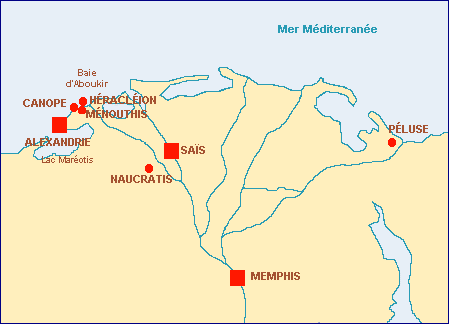
Fig 1: Map of Nile Delta showing Heracleion and Alexandria. Heracleion was located near the Canopic mouth of the Nile. Source: http://www.ieasm.org/
As per the ancient accounts, when Heracles had arrived in Egypt, the reigning king of Egypt was Busiris, who was advised by an oracle to make an annual sacrifice of a foreigner at the altar of Zeus, in order to end a famine that had struck Egypt. Heracles on his arrival in Egypt was seized and led to the altar, but he broke his chains and slew Busiris, together with his son Amphidamas, and offered them at the same altar.
Diodorus Siculus (c.50 BC) relates another story with respect to Herculesiv. At one time the flooding of the Nile was so great that the whole of Egypt was under water. Prometheus, who was the overseer of a certain district in Egypt tried to stop the flood, but was not successful and was contemplating suicide out of despair. Hercules then arrived in the nick of time, and stopped the flood waters, and turned the river back to its former course.
It is of interest to note here that Balarama, too, was credited with diverting the course of the river Yamuna using his plough, while Hercules had diverted the course of the river Alpheus in order to clean the Augean stables. Therefore, the act of stopping the floodwaters of the Nile, and returning the river to its former course, was in keeping with the superhuman abilities that were traditionally attributed Hercules and Balarama.
The most interesting accounts, however, are related with respect to a personality called Belus. The Roman philosopher Cicero (c.106 BC) had stated that, “the Indian Hercules is denominated Belus”v, and he used the term Hercules Belus to refer to him. Since the Indian Hercules was Balarama, the elder brother of Krishna, I have used the compound term Hercules-Balarama (instead of Hercules Belus) to refer to this heroic personality. In this context, the term “Hercules” acts as an epithet of Balarama, since, as suggested by Colonel James Todd, the term Hercules may be seen as a compound of the terms “Hari-kula-es”, which means “Lord (es) of the race (kula) of Hari”.
Apollodorus (c.180 BC) tells us that Belus ruled over Egypt and Libya, while his twin-brother Agenor ruled over Tyre and Sidon in Phoeniciavi. Belus had two sons – Aegyptus (also known as Ramesses) and Danaus. Belus installed Aegyptus as the ruler of Egypt, and placed his other son Danaus over Libya. The 10th century writer Suidas, who compiled the voluminous encyclopedia of the ancient Mediterranean world known as the Suda Lexicon, wrote that Egypt derived its name from Aegyptus, the son of Belus:
“Ramesses, the son of Belus who was the son of Zeuth, came into the region called Mestraea (ancient Egypt), and gained the sovereignty, over the people of the country. He was the person, whom they afterwards called Aegyptus; and the region was denominated from him.”vii
However, there was also a prevailing belief that Aegyptus was another name of Belus, for according to Aeschylus (c.525 BC), the Greek poet and dramatist, “Belus having conquered the Mizraim (Egyptians) styled Melampodes, called the country, after one of his own titles, Aegyptus.”viii
These accounts provide us with a more detailed understanding of the events that transpired upon the arrival of Hercules-Balarama on the shores of Egypt. He controlled a flood on the Nile, deposed of a tyrant king called Busiris, and placed his son Ramesses (Ramesses= son of Rama i.e. Balarama?) on the throne of Egypt. Such was the impact of his achievements that Egypt henceforth became named after Aegyptus, which was the title of either Balarama or his son Ramesses.
Another interesting perspective concerns the twin brother of Belus called Agenor who ruled over Tyre and Sidon in Phoenicia. According to the German philologist Philipp Karl Buttmann, the genuine Phoenician name of Agenor was Khna.ix The Phoenicians, who were one of several peoples who belonged to the “Canaanite” subgroup of the Semitic peoples, traced their origins to this ancestor called Khna (or “Canaan”)x, after whom the land of Canaan (which included the coastal regions of modern Syria, Israel and Lebanon), is also named. In fact, the Greeks always used the term Khna for the land of Cannan, while the Egyptians referred to this region as the “land of kana’an”.xi
Now, we know that Balarama, too, had a younger brother called Krishna, and they were literally inseparable like twins. One of the very popular names of Krishna is Kanha (or Kanhaiya) meaning a “lovely adolescent”, which sounds very similar to the Phoenician Khna. In fact, the name Kanha is widely used in India even today, and in many families the elder brother is often called Bala (or its many variants) and the younger Kanha (or its many variants). Therefore, the twin brothers Belus-Khna can be recognized as the counterparts of Bala-Kanha or Balarama-Krishna.
The story of Belus, however, does not end here. He travelled to Babylon and carried out many herculean tasks there as well; and thousands of years later, the mysterious seafaring Phoenicians adopted him as their primary deity Melqart.
The Exploits of the Babylonian Belus
According to Diodorus Siculusxii , the King Belus of Egypt went with a colony out of Egypt and settled near the river Euphrates, while Pausanias (c.110 AD), the Greek traveler and geographer, states that Belus of Babylon had its name from Belus, an Egyptian. At Babylon, Belus instituted an Order of Priests, after the manner of the Egyptians, whom he exempted from public taxes and offices, so that they might devote themselves to the study of Astrology and make celestial observations.
The Babylonian Belus was regarded as an ancient king who founded Babylon. The Roman historian Eusebius (citing Abydenus, who took his history from the ancient monuments of the Chaldeans) writes:
“It is said that all (Babylon) was originally water, and called a sea. But Belus put an end to this, and assigned a district to each, and surrounded Babylon with a wall; and at the appointed time he disappeared. And Afterwards Nebuchadnezzar built the wall which remained to the time of the Macedonian Empire, and was furnished with gates of brass. ”xiii
Babylon was uniformly regarded by the ancient historians as a stunning city of enormous proportions. Herodotusxiv, who had visited Babylon, said that the city was laid out as an exact square of sides 12 miles each. The entire city was encircled by high walls, 350 feet high and 87 feet thick, built with large bricks cemented with bitumen. The city was encompassed by a vast ditch filled with water. The earth which was dug out from this ditch was employed in making the bricks for the gigantic walls of the city. The city had 100 gates of brass, 25 on each of the four sides. Between every two of these gates were three towers, raised ten feet above the walls. The Euphrates River divided the city into two parts, and a 60 feet wide bridge over the river linked the two halves. The center of each division of the town was occupied by a fortress. In the one stood the palace of the kings, and in the other was the sacred precinct of Jupiter Belus.
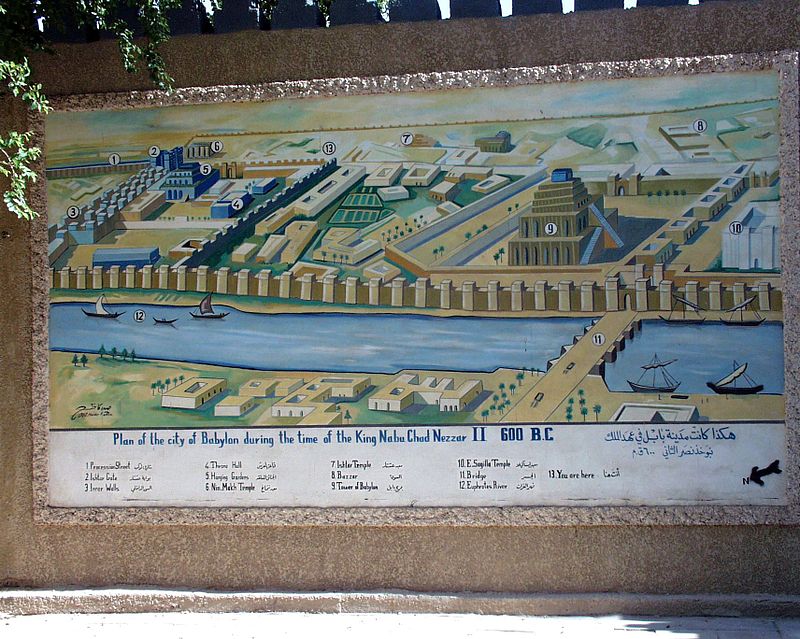
Fig 2: Plan of the city of Babylon during the time of the king Nebuchadnezzar II, 600 BC. Source: Wikipedia
It is no coincidence that Balarama was also credited with the building of enormous cities and grand palaces. While Belus built the city of Babylon by reclaiming land from the sea, the brother deities Krishna-Balarama had reclaimed land from the Arabian Sea and built the island-kingdom of Dwaraka, (which was submerged under the ocean at the end of the Dwapara Yuga). Balarama also built the city of Palibothra (modern Patna), which was the capital of ancient India. Strabo says that Palibothra was the largest city in India, situated at the confluence of the Ganges and Erranaboas (Sone) rivers. He says, on the testimony of Megasthenes, that Palibothra was shaped like a parallelogram with sides of length 8 miles and breadth 1.5 miles. The ditch, which enclosed it, was 600 feet wide and 45 feet deep, and it received the sewage of the city. The city was surrounded by a high wall with 570 towers and 64 gates. Diodorus Siculus adds that the walls, that is to say, the upper part or parapet, were of wood, with loop-holes for discharging arrows. Pliny states that there was no city in India which rivaled Palibothra in its magnitude and splendour.xv
There is a distinct similarity between the architecture, layout and scale of these two ancient cities, Babylon and Palibothra, which supports the idea that they were built by the same person. Even chronologically, it appears that Belus and Balarama lived during the same time period.
There are a number of different opinions regarding the time when Belus lived, and how long he ruled at Babylon. One of the derivations is highly relevant for this analysis. According to Philo (d. 50 AD), the Hellenistic Jewish philosopher of Alexandria, and some other ancient writers, Belus built Babylon 2000 years before the time of Semiramis, the wife of Ninus, who had ascended the throne after her husband’s death and carried out many magnificent works of art and civilian architecture throughout her empire.xvi Now, Diodorus Siculus places Ninus about 1950 years before the Christian era, nearly about the time of Abraham. xvii This would mean that Belus lived (1950 + 2000) i.e. nearly 3950 years before the Christian era. This is very close to the end of the Dwapara Yuga in the Indian Yuga system in 3976 BC (using the Saptarshi Calendar as the basis of the Yuga Cycle).xviii It was at the end of the Dwapara Yuga that both Krishna and Balarama departed from this world, after a lifetime of extraordinary achievements. This concurrence of dates is very significant, and gives us a very good reason to think that these stories, which have been relegated to the realm of myths, are actually based on real historical events of a long forgotten past.
Belus also established the Babylonian royal dynasty, which ruled for many centuries after him, and even Nebuchadnezzar II (d. 562 BC), who had rebuilt and adorned the city of Babylon, considered himself to have descended from Belus. In India, too, the posterity of Balarama reigned for many centuries in Palibothra (Patna), but, as Diodorus Siculus reports, they did nothing worthy of being recorded. Like Hercules and Balarama, Belus also came to be regarded as a god after his death, and was worshipped by the Hebrews as Bel or Baal.
The Symbolism of Baal and Melqart
Since the very ancient times, the Hebrews and Canaanites worshipped Bel or Baal. He was the patron god of Nippur, and his name meant “lordly, dominant”. Baal was also the tutelary deity of Babylon. Although, the term Baal was used as an honorific or title for many gods of the Levant and Asia Minor, it was also used absolutely of a god Baal, in such forms as Ish-baal (“Man of Baal”) or Hannibal (“Favor of Baal”).
The phonetic similarity between the names Baal and Balarama (or Balram) is the first thing that strikes one. The name Bala-Rama means the “Strong Rama” since Bala means “strong”. Balarama was, therefore, simply referred to as “Bala” or as “Rama” (not to be confused with the monarch Rama of Ayodhya). Phonetically, “Bala”/ “Bal” and “Baal” are nearly identical, which supports the hypothesis that we are talking of the same person. Interestingly, the term “Bal” is still a widely used surname in India, just as it was used in ancient times as a suffix for names such as Hannibal or Ishbaal.
Like Balarama, Baal was the giver of victory, (“Baal the Conqueror”) and the patron god of rains, growth, fertility, and the produce of the soil. As Baal-Hadad, he was the storm and rain god, and the lord of the sky (“Rider in the Clouds”). He appeared bearded, often holding a club and thunderbolt, while wearing a bull-horned headdress. It was with his magic club that he defeated Yam, the God of the Sea, in battle. As discussed in the earlier articles, the club and the bull-horned headdress are also attributes of Balarama.
The shrines to Baal always had a sacred tree-stem or pole planted beside it, and he is frequently shown holding a tree stem in his hand. Sacred pillars were also often built close to the shrine.xix This is something we find in both Hindu and Jain iconography. One of the symbols associated with Balarama is the palm tree. A pillar, crowned by a palm capital, was a symbol of Balarama who was called Talanka.xx The palm tree was also the symbol on the standard of Balarama’s chariot which was called Taladhvaja.
Therefore, if we follow the traditional narrative and explore the symbolic connections, it becomes quite obvious that the King Belus of Egypt and Babylon, and the deities Bel or Baal of the Hebrews, are in fact the same heroic personality – Hercules Balarama.
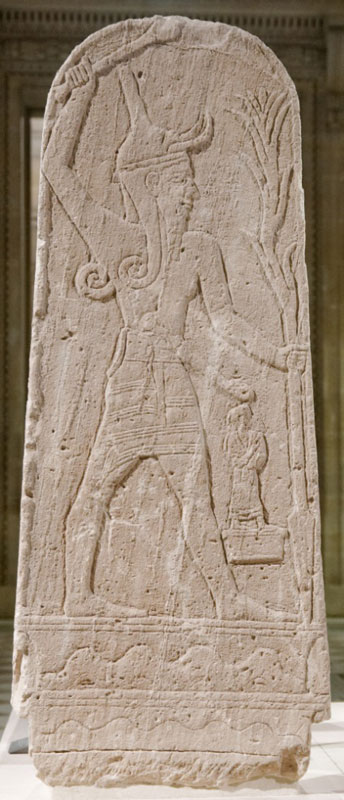
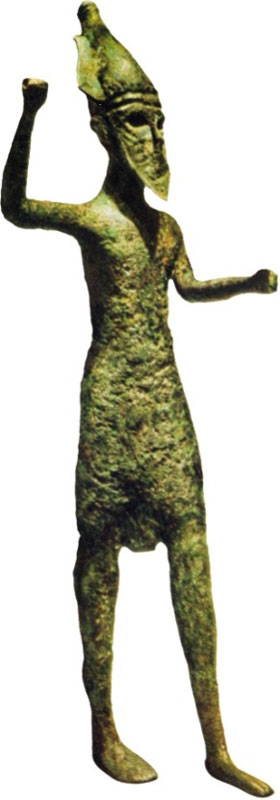
Another interesting development took place in the Mediterranean region from around 1550 BC, which provides further evidence in support of this argument. The Phoenicians, a mysterious seafaring people, began to emerge as an enterprising, maritime, trading culture that spread across the Mediterranean, and established many port cities. The Phoenicians worshipped a god called Melqart, who was the tutelary deity of the Phoenician city of Tyre.
Melqart was also referred to as “Baal Melqart”, and as the “Baal of Tyre”. Melqart’s name signified, the king of the city; according to others, and with greater probability, “the powerful king”. The Phoenicians regarded him as the god of harvests and of the table, the god who brings joy in his train. A mercantile and commercial people, they also made him the protector of commerce and colonies.xxi A bronze statue of Melqart depicts the god in a manner very similar to Baal i.e. with a beard, wearing a conical headdress, and with upraised hands ready for combat.
Melqart was also referred to as Belus, a name by which the Indian Hercules i.e. Balarama was also known. In addition, the Greeks identified Melqart with Heracles, and referred to him as the Tyrian Heracles. A number of coins issued by the Phoenician city of Tyre shows Melqart with the lion’s skin tied around his neck on one side, and on the observe side, an eagle with the branch of a palm over the right wing, and a club to the left. The lion’s skin, club and palm branch are all symbols of Hercules-Balarama.
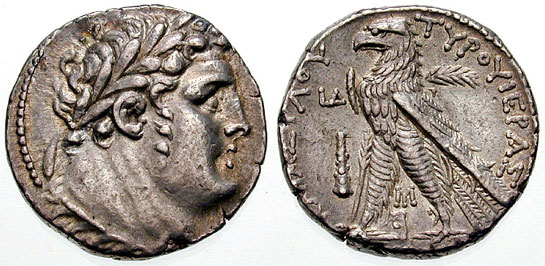
Fig 5: Laureate bust of Melqart, with lion skin tied around neck / eagle standing left on prow, palm branch on right wing, club to the left. Tyre, Phoenicia. 123/122 BC. Source: http://www.wildwinds.com/coins/greece/phoenicia/tyre/i.html
So, once again, we have a convergence of many different epithets for the same person; for Melqart is represented as Baal, Belus as well as Heracles. This implies that we are, in essence, talking of a single person of extraordinary abilities, Hercules-Balarama, who had roamed the earth thousands of years ago, and carried out many incredible acts of heroism, courage and benevolence, because of which he was deified after his death, and came to symbolize strength, protection, fertility and kingship. Everywhere he went, he built massive fortified cities and grand palaces, started royal dynasties, and also instituted laws and customs related to priesthood, astrology and astronomy.
This person, Hercules-Balarama, was native of India, as attested by the Greek historians, and was the elder brother of Krishna. Orientalist Thomas Maurice wrote in the Indian Antiquities (1812) that:
“This Indian Hercules, therefore, this enterprising god-king Belus, is the true prototype of him who was worshipped at Tyre, and was the great promoter of commerce and navigation; of him who was adored as the vanquisher of Busiris in Egypt…; of him, in short, whose complicated history was in after-ages, with all its extravagances, adopted by the fabulous Greeks.”xxii
It was in Egypt, however, where Hercules-Balarama played an extremely significant role, which has largely remained unexplored. As per the ancient sources, he had deposed of a tyrant king called Busiris and established his own son Ramesses on the throne of Egypt, and thereby kickstarted in new phase in Egyptian history. His appearance on the earth towards the end of the Dwapara Yuga, sometime around 4000 BC, corresponds to the Predynastic Period of Egypt – more specifically with the Naqada I or Amratian Period (from 4000 BC-3500 BC).
The Naqada I period was characterized by a number of new innovations such as new forms of pottery design, aesthetically pleasing and complex art forms, development of architecture including the rectangular clay brick homes, towns and urban planning etc. which were subsequently carried forward into the art and architecture of the Dynastic Period (from c.3100 BC). Therefore, there are clear signs of an infusion of new forms of art and technology during Naqada I period which may be attributed to the arrival of King Belus in Egypt. This timeline also explains why Egyptologists have been unable to map the Egyptian kings Belus and Busiris to any of the known pharaohs of the Dynastic Period; for these events had transpired nearly a thousand years prior to the beginning of Dynastic Egypt in c. 3100BC.
The most striking legacy that Hercules-Balarama left behind in ancient Egypt, however, is with respect to the institution of Kingship. An analysis of the array of mysterious and confounding symbols associated with the regalia of the Egyptian pharaoh reveals that, all throughout Dynastic Egypt, the pharaoh was simply trying to imitate Hercules-Balarama, who symbolized power, authority and kingship across much of the ancient world. This idea has been explored in detail in Part 2 of this article.
See Part 2 of this article
End Notes
i Bibhu Dev Misra, Hercules and Balarama: The Symbolic and Historical Connections, Mar 6, 2014, http://bibhudev.blogspot.in/2014/03/hercules-and-balarama-symbolic-and.html
ii Bibhu Dev Misra, Balarama and Khonsu: Comparisons between the Indian and Theban Hercules, April 27, 2014, http://bibhudev.blogspot.in/2014/04/balarama-and-khonsu-comparisons-between.html
iii Herodotus 2.113
iv Diodorus I.19.1-2
v Cicero De Natura Deorum, lib iii
vi Apollodorus, Bibliotheca 2.1.4
vii Suidas, taken from Jacob Bryant’s Analysis of Ancient Mythology, p 235-236
viii Aeschylus, Prometheus Bound, p 52
ix Taken from Wikipedia, topic “Agenor”
x David Noel Freedman, Allen C. Myers, Eerdmans Dictionary of the Bible, Amsterdam University Press, 2000, p 1054
xi A. H. (Archibald Henry) Sayce, Patriarchal Palestine, Tredition, 2012
xii Diodorus Siculus, Bibliotheca 1, p 17
xiii Eusebius 9.41 who cites Abydenus’ Concerning the Assyrians, taken from Wikipedia
xiv Herodotus I.178
xv William Franklin Black, Inquiry concerning the site of ancient Palibothra, 1815, p 49
xvi John Jackson, Chronological Antiquities, 1752, p 234
xvii Diodorus Siculus, Bibliotheca, Book 2
xviii Bibhu Dev Misra, The end of the Kali Yuga in 2025: Unraveling the mysteries of the Yuga Cycle, July 15, 2012, http://bibhudev.blogspot.in/2012/07/end-of-kali-yuga-in-2025-unraveling.html
xix Jewish Encyclopedia (1906), http://www.jewishencyclopedia.com/articles/2236-ba-al-and-ba-al-worship
xx Nilakanth Purushottam Joshi, Iconography of Balarama, Abhinav Publications, 1979, p 24
xxi Charles Anthon, A Classical Dictionary, Harper & brothers, 1872, p 601
xxii Indian antiquities, Thomas Maurice, 1812, p 155-156
About the author: Bibhu Dev Misra is a graduate of the Indian Institute of Technology and the Indian Institute of Management and has been working as an Information Technology consultant for more than 14 years. He is also an independent researcher and writer on topics related to ancient civilizations, myths, symbols, science and religion. His research has taken him to many places of historical interest across the globe. His articles have appeared in different journals, magazines, and websites including the New Dawn, Science to Sage, Comsomath, Graham Hancock Forum, Esamskriti, Viewzone and others. He can be contacted at [email protected] and via his personal blog: http://bibhudev.blogspot.com
More articles by Bibhu Dev Misra:
A Day and Night of Brahma: The Evidence from Fossil Records
The Opet Festival of Ancient Egypt: Has it been derived from the Jagannatha Rathyatra of Puri, India?
Evolution by Catastrophe: Does it indicate Intelligent Design?
Petra, Jordan – Is it an ancient Shiva Temple complex?
The journey of Jagannath from India to Egypt
The end of the Kali Yuga in 2025: Unraveling the mysteries of the Yuga Cycle





